This site is part of various affiliate programs. Links may give us a small compensation for any purchases you make, at no additional cost to you. Please read the disclaimer policy for full details.
If you’re in a rush and don’t have time to read this article, then the best Canon film camera is the Canon AE-1.
Canon are one of the largest and most successful camera manufacturers of all time, from humble beginnings producing film cameras way back in the 1930s to the modern, high-end digital cameras of today.
But if you are interested in their earlier Canon film cameras, where do you start?
Particularly for those looking for their first Canon analog camera, you need to undertake a lot of research to be sure that the vintage Canon film camera that you have your eye on is not a dud, and can be used for the style of photography you want, without breaking the bank.
There is such a huge range of these types of film camera, from Canon SLR film cameras, to rangefinders and Canon point and shoot film cameras. Should you go for a fully electronic or mechanical model, and does it offer automatic metering, autofocus or other modes, or is it partially or fully manual?
This article contains all of my years of knowledge of cameras and photography to answer all of these questions, and more, so that you fully understand the complexities of these models, ranging from the Canon AE-1 35mm film camera, down to the Canon EOS film cameras, and will give you a few good choices for those Canon film cameras that can still be bought for a fair price.
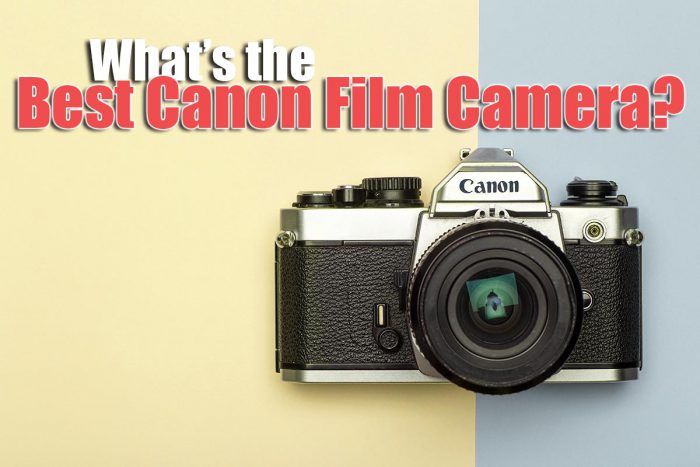
The Best Canon Film Camera
Classic Canon Film Camera
- Widely available at a fair price
- Canon’s first camera with a microprocessor for program mode
- Lightweight and fits in the hand well
- Classic vintage Canon design
- Uses cheaper (though still optically excellent) FD lenses
Read More:
Download the Canon AE-1 manual
Comparing the Top Canon Film Cameras
Camera | Pros | Cons | Check Price | |
[Best Canon Film Camera] | Classic design; Program mode; Fits the hand well | Harder to find battery | ||
Very easy to use; Lightweight; Budget choice | Lower build quality | |||
User friendly; Excellent autofocus; Sturdy | Dials can be flimsy | |||
Good value with kit lens; Plenty of shooting options | Plastic housing affects durability | |||
Professional build quality & operation; Excellent autofocus | Expensive | |||
Brilliant rangefinder; Shutter priority mode | Aperture ring can be tough to turn |
Related Article:
How to Choose the Best Canon 35mm Film Camera
There are a handful of important considerations that you need to bear in mind when looking for the best Canon 35mm film camera, which are covered below. This guide should help you to get an understanding of how much variety there is between film cameras when compared to digital cameras.
For example, a film camera manufactured in the 2000s is going to be closer in operation to a digital camera than one made in the 1970s, which might lack autofocus, aperture priority modes or even a light meter.
The key areas that you need to consider here are:
- Budget
- Manual vs Automatic Modes
- Electronic vs Mechanical Operation
- Lens Availability
- Camera Condition
What Is Your Budget?
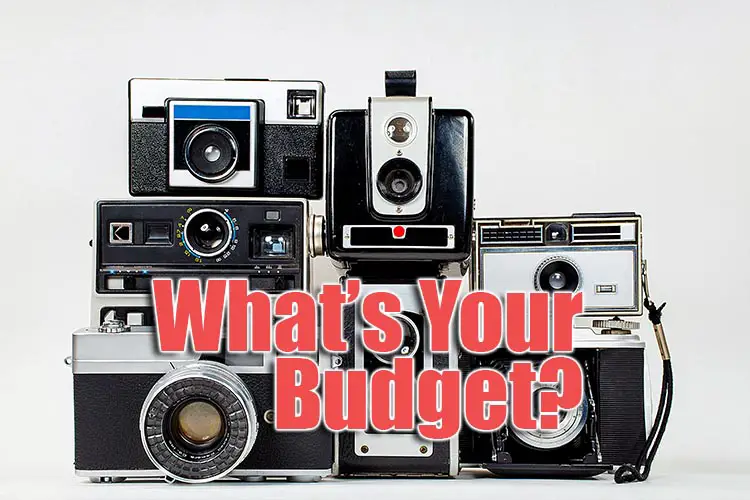
Your budget is an important consideration when purchasing a Canon 35mm film camera. When you consider the prices of Canon film cameras available, they can range from as low as $15 to more than $1,000. A brand new 35mm film camera with a regular lens can cost between $300-$500 (if you can find one brand new), while a vintage collector’s model camera in pristine condition without a lens, can cost over $1,000.
However, film cameras are long lasting and if well maintained, they can even last up to 50 years or more. You can get used 35mm film cameras that are in quite a good condition for a lot less, at prices ranging between $30 to $300.
Film cameras are making a comeback and you may find that some models of cameras have retained their value over time and some of them selling for more than they sold 10 years ago.
The prices for the same model of 35mm film camera tend to vary depending on factors such as the popularity of the model in question, its quality and condition.
Bear in mind that if you are looking for a real budget model to test out film photography, then you would be better off looking lower down my list, as these are the less popular models, and so sell for a lower premium.
Manual or Automatic?
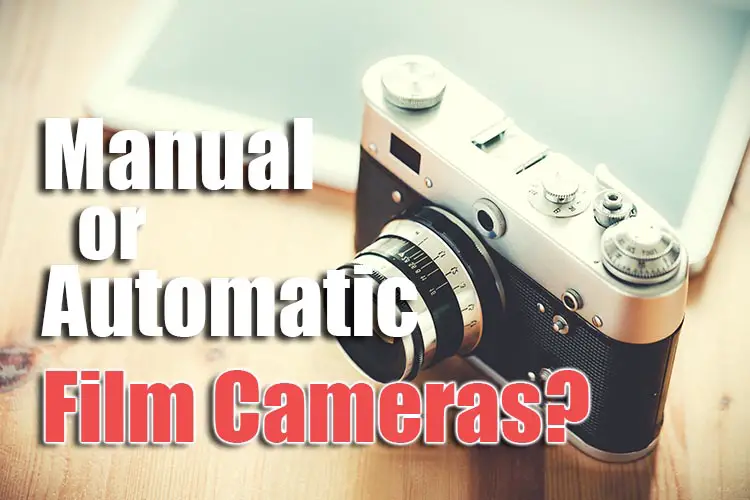
When buying a 35mm film camera an important thing to think about is whether you want a manual camera or an automatic one. Older cameras were usually manual cameras where you needed to set the aperture and shutter speed manually according to the output of the light meter. This made it easier to mess up your photos if you weren’t paying attention, and required more work to get a good result.
However, manual cameras offer a better platform to learn and understand the principles of photography. An automatic camera is essentially a point-and-shoot film camera where all you need to do is point the camera and shoot. They might offer the ability to set functions manually, but also have an automatic mode that calculates the correct exposure for you and sets the aperture and shutter speed appropriately.
You should note that the definition of automatic film camera has changed over the years. The older automatic cameras had a range of features such as in-built light meters, auto film rewinding, etc. However, cameras that were available around the 1990s had more advanced features such as autofocus and auto exposure, making photography a lot easier, especially for beginners.
The only drawback of some automatic film cameras (particulaly older ones) is that they use CR123 and CR2 batteries, which can be rather difficult to find, even online.
Electronic or Mechanical Cameras?
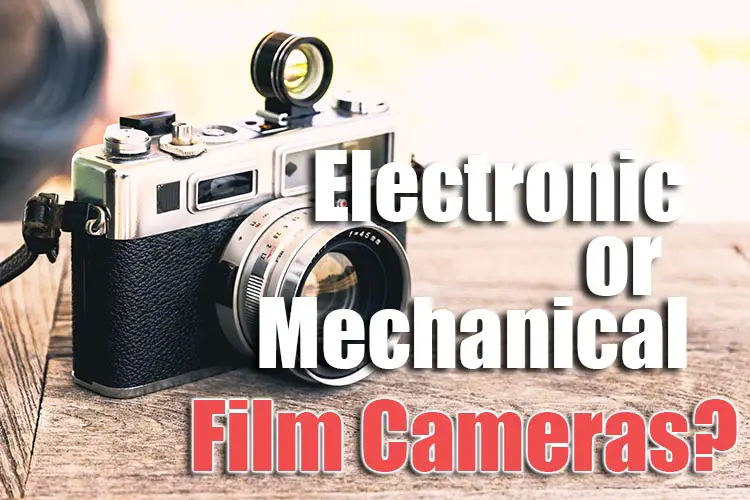
You must determine whether you want an electronic film camera or a mechanical one and to do that it’s a good idea to evaluate the pros and cons of each option before making your decision.
Electronic Cameras
Electronic cameras may be partially electronic, which means that the shutter is electronically controlled, however the winding and focusing are manual, or they can be fully electronic, with everything including exposure control, winder, focus and shutter, all controlled electronically. These cameras obviously need batteries to work.
Electronic cameras are more long lasting as they have fewer moving parts compared to mechanical cameras, which have levers, gears, chains, cords and springs that can clog up, disengage, wear out or break over time.
Electronic cameras have solid-state non-moving electronics, making them sturdier and more reliable and this is especially an important factor when it comes to older 1970s camera models.
Electronic cameras do not go out of adjustment and are more accurate compared to mechanical ones and the exposures of electronic cameras are more precise compared to mechanical cameras. However, when you consider the focus of the camera, an electronic focus is unreliable compared to a mechanical focus, where a screw directly moves the glass elements of the lens to achieve focus lock.
Electronic cameras offer faster flash sync speeds of 1/125-1/250 sec compared to mechanical shutters that deliver 1/60 sec. Finally, electronic cameras are much cheaper compared to mechanical models.
Mechanical Cameras
Typically, a mechanical camera does not have any electronics in the exposure, film winding or shutter mechanisms and works fully without the need for a battery. Mechanical cameras are easier to repair compared to older electronic models which have flexible printed circuit boards that may crack over time. And finally, mechanical cameras give you the actual feel of real photography and are a treat to use.
Because mechanical cameras tend to be on average much older than electronic cameras, they are either much cheaper for less popular models, or much more expensive for those prized by collectors. There is limited pricing middle-ground for fully mechanical cameras.
Lens Availability

You may have found a beautiful 35mm film camera at a very good price; however, after purchasing it, you may not be able to find the lens you want that is suitable for the camera. While you might expect that a Canon film camera is compatible with all types of Canon lenses, this is not acutally the case.
For instance, older Canon camera models such as the Canon AE-1 make use of FD lenses, which were discontinued and their manufacture was stopped in the early 1990s. You may be able to find the lenses you want for your camera online or in specialty camera shops; however, these are usually second-hand lenses which might have taken some knocks and bumps along the road, and lack features such as autofocus.
More recent Canon 35mm film camera models make use of EF mounts. While EF lenses are still being manufactured and you can purchase good quality lenses quite easily, these lenses are more expensive than FD lenses. An advantage of EF lenses is that you can use them on both DSLRs (preferably full frame) or on compatible film cameras, meaning that if you already have a stash of these lenses, then a basic Canon EF film camera can be a very easy way to get into film photography.
Camera Condition
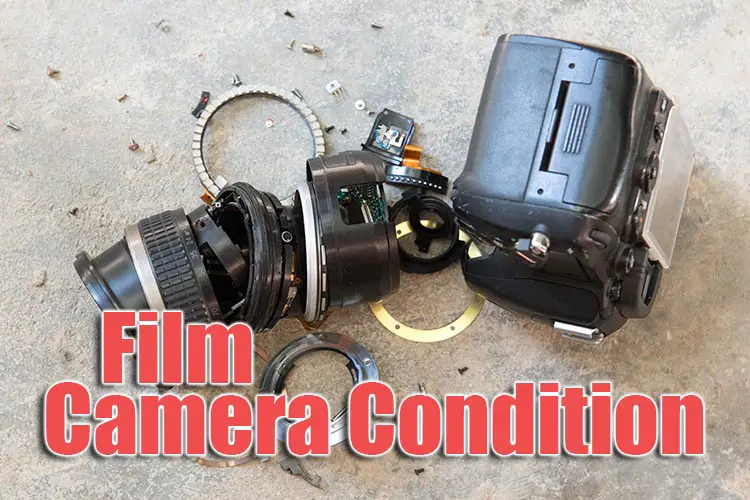
Ideally, it is a good idea to purchase a film camera only after checking its condition and testing it. Check the physical condition of the camera to ensure that it has not been dropped. Ensure that all the switches and dials are working properly. Check the film loading mechanism by opening and closing it.
Gently shake the camera and if you can hear any rattling, this can indicate some broken parts, particularly if it comes with a flash unit.
Check the camera and the lens for any mold. If you have the opportunity take a photo, but otherwise just press the shutter button and make sure the shutter curtains move and the film winds.
However, if you’re buying the film camera online, make sure that the seller is reputable and has a good selling history. Purchase the camera from a tried and tested seller such as KEH or Used Photo Pro, rather than eBay or Amazon, that accepts returns in case of a defective product.
Before purchasing the camera, ask the seller to send you clear pictures of the camera. Ask questions such as if the camera and all its parts are working properly, if it comes with batteries, etc. Read the descriptions, as well as the reviews on websites such as eBay, Amazon, etc.
Check out what people are saying on forums about the various features and functions of the camera including autofocus, film winding, shutters, light meter, film doors, battery, timing functions, etc. This can be a very good source to find out which parts of a particular camera and prone to breakage. All of the cameras below are very solid models where this shouldn’t be a major problem.
Purchase the camera only if you find positive reviews about the product, seller and if you’re completely satisfied.
Reviews of the Best Canon Film Cameras
This is just a selection of the best Canon film cameras you can buy right now, with availability a major factor in my choices. Any of these would be an excellent first step into film photography.
1. Canon AE-1 Film Camera / AE-1 Program [Best Canon SLR Film Camera]
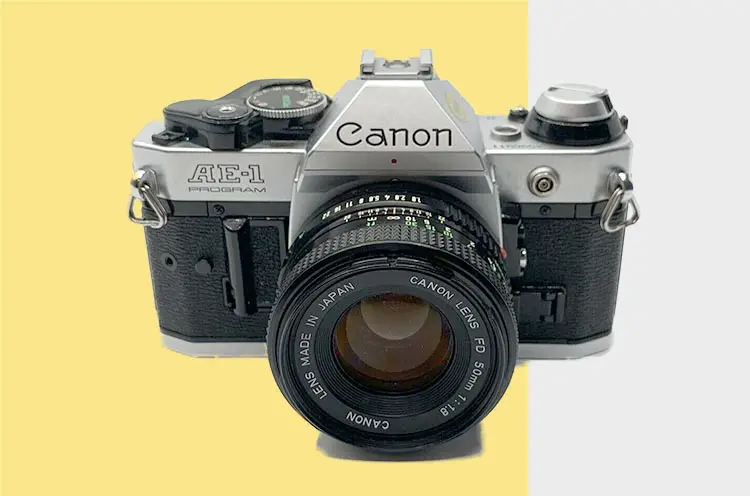
Launched in 1976, the Canon AE1 became very popular with both amateurs, as well as professional photographers. Since the production of the Canon AE-1 was stopped in 1984, the cameras you are likely to find in the market will be more than 35 years old. Regarded as one of the best 35mm film cameras, the classic camera has a sturdy design and build.
Made of a combination of metal and plastic components, the Canon-AE1 is a simple camera that is very easy to handle and use. The 35mm SLR camera has an electronically controlled focal-plane shutter and automatic exposure. The Canon-AE1 is very lightweight; however, it may not be very durable.
The AE-1 has minimal auto functions, which may not make it very suitable for beginners. However, the camera offers good, clear and vibrant images. The best thing about the AE-1 is that it is compatible with all FD mount lenses.
It lacks aperture priority in favor of shutter priority and a full-auto program mode in the Canon AE-1 Program variant. If you want aperture priority and an all-metal construction, then the later Canon A-1 is a good choice.
Overall, the Canon AE-1 is a simple but well-made camera that is available at a very affordable price, making it a good budget camera, and the best Canon film camera.
Pros:
- Very lightweight thanks to the plastic build
- Fits in the hand very nicely and is very easy to use
- Compatible with all Canon FD lenses
- Has electronic shutter control
- Has a microprocessor giving shutter priority and program modes
- Affordable
Cons:
- No apeture priority mode
- Needs a harder-to-find battery
- Has plastic parts, which reduces the durability, and causes squeaks during use
->> Check Latest Price
2. Canon EOS Rebel G [The Best Canon EOS Film Camera]
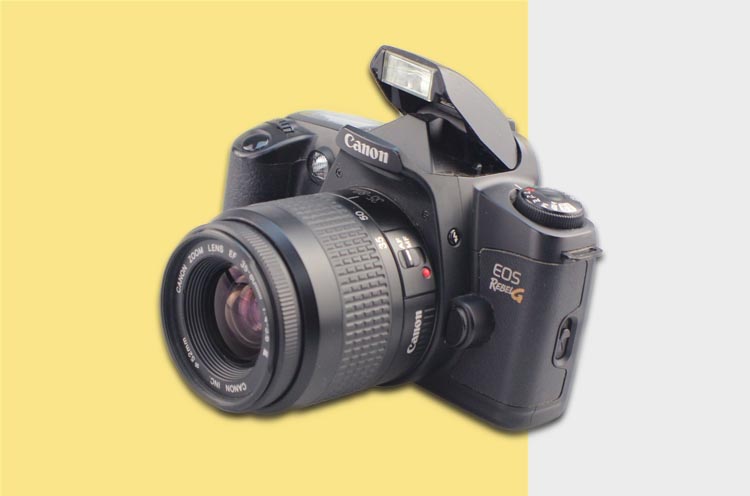
The Canon EOS Rebel G, originally called New EOS Kiss in Japan, was launched in 1996 and is the best Canon EOS film camera.
The 35mm single-lens reflex camera was replaced by the Canon Rebel 2000 in 1999, which makes a good budget substitute for the Rebel G. The Rebel G is a simple, lightweight camera with an all-plastic body, and is available in 2 colors: all black or black and silver.
This Canon EOS Rebel film camera features an EF lens mount and is compatible with all Canon EF lenses, including modern ones, which is a real benefit. The Rebel G is extremely functional and features a viewfinder that offers 90% coverage, 0.7x magnification, wide autofocus, center autofocus, etc. The camera has 11 shooting modes – 6 basic, landscape, portrait, full auto, sports and macro modes along with 5 advanced modes.
The Rebel G is among the few cameras that take photos in reverse order by winding the film right to the end. The camera has a retractable inbuilt flash and red-eye reduction control. The Rebel G is quite inexpensive, yet produces good quality photos. Lightweight, compact and easy to handle, the Rebel G is a good camera for beginners and students, particularly if you already own some EF glass.
Pros:
- Very easy to use – similar to modern DSLRs
- Compact and lightweight
- Produces good quality images
- Modern metering system
- The shutter and mirror are very quiet
- Good budget choice
Cons:
- The finder is very small and dim
- Build quality is lower – camera is all plastic
- Manual control is not very intuitive
->> Check Latest Price
3. Canon EOS A2E
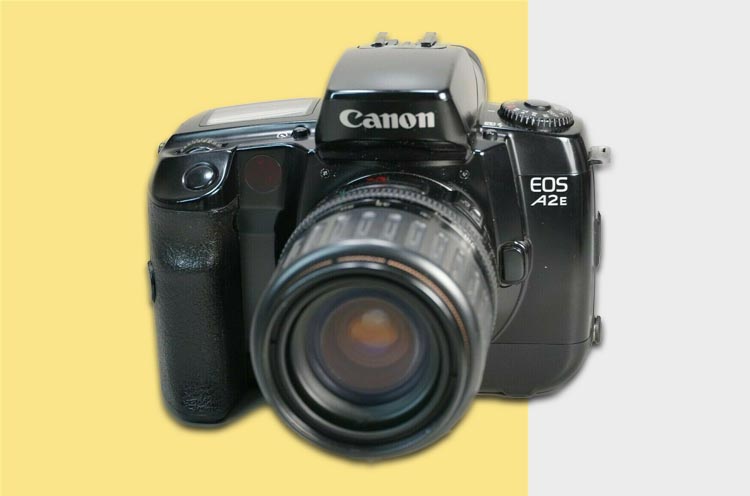
The Canon EOS A2E was introduced in 1992 and was also sold as Canon EOS A2 and EOS 5 (outside North America). When it was launched, the EOS A2E was the top product on the EOS camera line. The 35mm SLR film camera has advanced features like eye-controlled autofocus and auto exposure.
Equipped with an EF bayonet lens mount, the camera is compatible with all new lenses. The A2E has 2 dials to adjust the shutter speed and aperture settings and is a very versatile camera with a high-quality build.
The Canon A2E has many modern features that would be familiar to DSLR users, including many pre-set auto exposure modes, in-built zoom flash, fast motor drives and AF light assist.
The camera has several operational modes that can be selected using the dial, 3 in-built metering modes and 1/8000 top shutter speed. The camera is a good choice for photographers who want a user-friendly camera.
The drawback of this model is that it uses 2 6-volt CR5 batteries, which are quite difficult to find, or you can use a battery pack with D batteries.
Nevertheless, with all its features and functions and digital camera-like functionality, the Canon A2E is a solid 35mm semi-professional camera suitable for any photography enthusiast, and is available at a very fair price.
Pros:
- User-friendly camera
- Affordable price
- Eye-controlled autofocus
- Sturdy build
- Uses EF lenses
Cons:
- Batteries are quite difficult to find
- The body coating of the camera can become sticky over time
- Flimsy radial dial
->> Check Latest Price
4. Canon EOS Rebel 2000
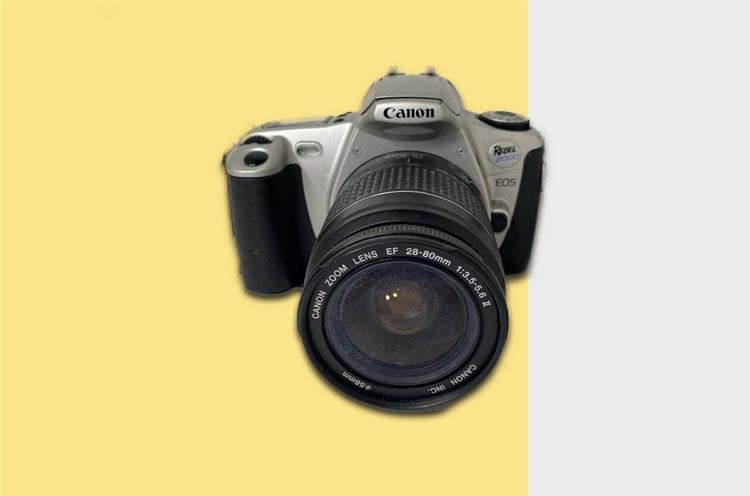
The Canon EOS Rebel 2000, also known as Canon EOS 300 or EOS Kiss III, was produced from 1999 to 2002 by Canon of Japan. The camera has a full polycarbonate body, which makes it extremely lightweight and easy to handle.
The 35mm SLR camera has loads of useful features, such as a 7-point autofocus feature with full manual option, retractable in-built flash, a pentaprism viewfinder, and a 35-Zone exposure sensor with 3 exposure modes. The 7-point focus point allows you to use the Rebel 2000 for creative photography.
Getting it in a kit with the 28-80mm lens for around $150 makes this a real bargain.
The camera also features an advanced LCD display and several modes like manual, portrait, landscape, night scene, full-auto modes. You also have the option of choosing from the shutter-speed priority and aperture priority modes.
The camera is powered by two 3-volt CR2 batteries that you can find online. The Rebel 2000 is a basic SLR that does all that an automatic SLR must do and delivers good quality images, although it definitely looks modern, and so isn’t for you if you are looking for a more vintage camera.
Pros:
- Fully automatic SLR camera
- Quiet and easy operation
- Several different shooting mode options
- Very fast autofocus
- Good value with the kit 28-80mm lens
Cons:
- The plastic housing of the camera affects its durability
- Autofocus may not work very well in low-light conditions
->> Check Latest Price
5. Canon EOS-1V
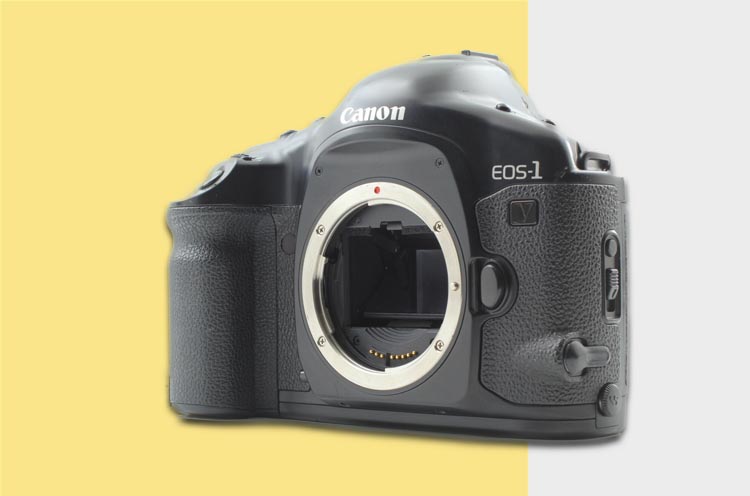
The Canon EOS-1V was a top-of-the-line 35mm SLR film camera in the EOS series, which was launched in 2000 but was discontinued in 2018. Made completely of metal (magnesium alloy), the EOS-1V is sturdy and durable. With its minimalistic design and rounded edges, the camera is very easy to hold and use.
The EOS-1V has loads of advanced features like a shooting speed of 10 fps, a 45-point autofocus, an NP-E2 Ni-MH battery pack and a PC link for data transfer and remote control. The weather sealing of the EOS-1V is among the best in the history of 35mm film cameras from Canon.
The camera pairs well with the L-series telephoto lenses, which allow you to shoot in any type of conditions and the viewfinder with the glass pentaprism shows 100% of the frame (which is not a given), while being very bright. A solid camera, the rugged EOS-1V is smooth, fast, quiet and easy to use, making it a great professional camera.
Pros:
- Excellent autofocus system
- The viewfinder is large, bright and very clear
- Sturdy and rugged all-metal build
- Easy to use
- Minimal mirror flap and shutter vibration
Cons:
- Quite an expensive camera
- The AF area must be selected using 2 dials
->> Check Latest Price
6. Canon Canonet G-III QL17
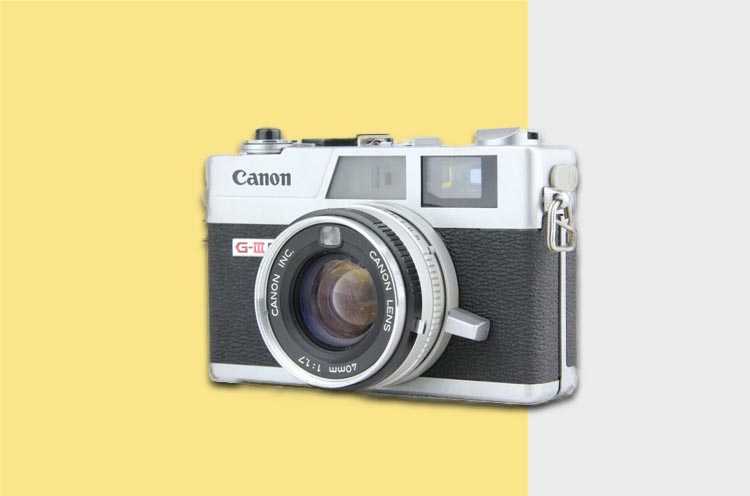
Manufactured by Canon in 1972, the Canonet G-III QL17 is a leaf-shuttered, rangefinder 35 mm camera with a fixed focal length. With its retro looks, the Canonet G-III QL17 was a best-selling rangefinder camera.
The Canonet G-III QL17 is equipped with a 40mm f/1.7 lens, an integrated light meter that provides manual modes and shutter priority and full manual control, making it a great camera for beginners. The camera has a max shutter speed of 1/500, which is rather slow and which may hamper your ability to shoot on bright, sunny days.
The Canonet G-III QL17 is equipped with the QL (quick loading) system that enables fast and easy loading of the film. The camera is small, compact but well-built and produces very good quality images. It works very silently and is quite inexpensive in terms of price.
Pros:
- Has a cute and compact build
- Quiet shutter sound
- Shutter priority mode
- Supports fully manual shooting modes
- Sturdy camera
Cons:
- The aperture ring around the lens barrel can be difficult to turn
- You can select the shutter speeds in whole stops only
->> Check Latest Price
Final Thoughts on Canon Film Cameras
There’s so much variety in Canon film cameras that coming up with one that is significantly better than the rest is pretty much impossible – it depends on what features you want and how you intend to use the camera that will determin the best one for you.
Nonetheless, it is indisputable that the Canon AE-1 is among the most popular Canon 35mm film cameras, and with its reasonable price, vintage look and easy usability, then if you can’t make a decision, the AE-1 is a very good place to start.
Classic Canon Film Camera
- Widely available at a fair price
- Canon’s first camera with a microprocessor for program mode
- Lightweight and fits in the hand well
- Classic vintage Canon design
- Uses cheaper (though still optically excellent) FD lenses
Read More:
What are the parts of a film camera?
What’s the best 35mm film for beginners?
How to find the best film cameras for beginners
What is the best point and shoot film camera?
AI Servo vs AI Focus: Compare Canon’s autofocus modes






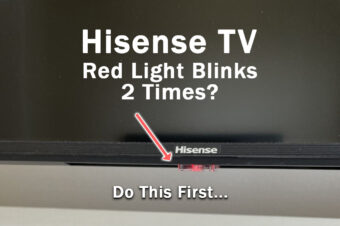

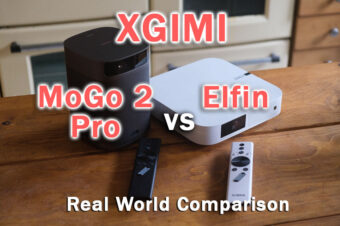

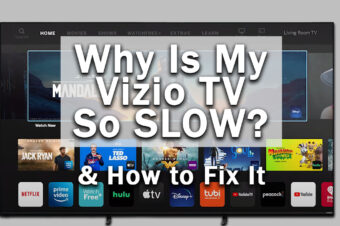
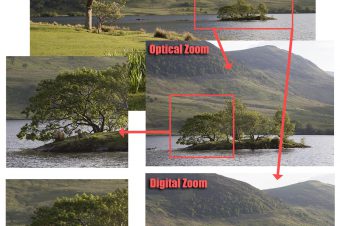
Leave a Reply